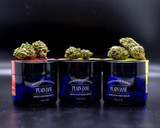Hemp flower is one of the most profitable new industries in the US. The benefits and uses of CBD hemp flower have been talked about extensively. What is less known are the terms used to describe the botany of hemp flower, and the cultivation process.
The hemp flower gets a lot of attention because it is the part of the plant that is smoked or extracted for CBD. Like marijuana, hemp flowers come in a variety of strains. Each strain has unique traits like colors, flavors, and aromas. Hemp strains like Stress Killer, Sour Tsunami, and Pineberry all have different chemistry that imparts distinct flavors and effects.
Some definitions are needed to understand hemp flower botany. These terms all describe the basic anatomy of the hemp plant.

Table of Contents
Hemp Flower
Buds and flowers are terms used to refer to female hemp flowers. The bud is where cannabinoids and terpenes are most concentrated. Long hairs called pistils protrude from the flowers and darken in color as the plant ages. Dried hemp flowers are sometimes called nugs. Hemp buds are actually clusters of several tiny individual flowers. When buds cluster together at the top tip of a stem they are called a cola.
Hemp Leaves
Between buds, hemp grows small sugar leaves. Sugar leaves, like buds, are coated in tiny resin glands called trichomes. Large hand-sized fan leaves grow out from the branches of the plant and contain lower concentrations of plant compounds.
Hemp Flower Trichomes
Trichomes are a very important part of the cannabis plant. These tiny resin glands look like sugar crystals that coat the hemp flowers and darken in color as they dry and mature. The resin contained in the trichomes is a sticky substance. In nature, trichome resins help the plant defend itself. The resin contains natural plant compounds, including cannabinoids and terpenes.

Hemp Biochemistry and Terminology
Underneath a plant’s appearance is a complex living system. Plant biochemistry is where form meets function. Plants are made up of cells. Some cells travel freely, and others bind together to form structures like organs or organelles.
Cells are made of organic chemical compounds like carbon, nitrogen, and oxygen. Plant cells also need inorganic chemicals like magnesium, copper, iron, and silica. These chemical constituents are assembled by cells into plant compounds.
Essential Hemp Plant Compounds
Plant compounds can be necessary molecules like adenosine triphosphate (ATP) which is used for metabolic energy. More interestingly, plants produce non-essential compounds called secondary metabolites. These non-essential plant compounds grant the plant added protection and benefits. In nature, they help deter insects and diseases. However, humans have found their own uses for secondary metabolites like cannabinoids, terpenes, and flavonoids.
Secondary Metabolites- Cannabinoids, Terpenes, and Flavonoids
Cannabinoids are more accurately called phytocannabinoids when they come from a plant. The human body also produces cannabinoids called endocannabinoids. Cannabinoids are one major source of the health benefits of the hemp plant. Another beneficial plant compound found in hemp is terpenes.
Terpenes are found widely outside of hemp. In fact, hemp has many of the same terpenes and flavonoids that are found in fruits and vegetables. Like terpenes, flavonoids are another type of natural plant compound with health benefits. The difference between cannabinoids, terpenes, and flavonoids comes down to their chemical structure.
Hemp Growth Stages
One of the most fascinating things about the hemp plant is how it grows. Hemp is a “weed” that can grow feral in drainage ditches.
So why is there so much care put into cultivating it? That comes down to our desire to produce hemp that is rich in beneficial compounds. Cultivation methods not only support cannabinoid production. They also influence a strain’s flavor and aroma.
Poor cultivation conditions can lead to drought stress and nutrient deficiencies. In turn, this produces poor quality hemp flowers with poor flavor and little therapeutic benefits.
Cloning and Seed Propagation
Some hemp is grown by seed, but seeds can also be grown to produce mother plants for cloning. By cloning a mother plant, growers can be sure that the offspring will be female and will preserve the genetic traits of the mother plant.
Only female plants are desired because plants that bear seeds have lower-quality flowers. Male plants must be removed from the crop if they emerge to prevent pollination. If plants are stressed, female clones may turn into hermaphrodites that have both flowers and pollen sacs.
Vegetative Growth Stage
During the vegetative growth stage, hemp plants grow branches and leaves. Collectively these and flowers are referred to as the plant’s biomass. Vegetative growth lasts for two to three months. During this time plants need to be kept in more than 12 hours of light. Most growers use lighting routines of 14 to 16 hours to conserve energy costs while providing sufficient energy for growth. When hemp is grown outdoors, this light exposure time naturally adjusts with the seasons.

Floral Growth Stage
Except in auto-flower varieties, hemp plants need a critical short day length to trigger flowering. That means hemp needs long nights of 12 hours or more to trigger flowering. Naturally, this occurs as the days shorten with the season. Indoor growers and greenhouse growers need to have black-out systems in place to ensure this critical dark time is not disturbed.
Drying and Curing Hemp Flower
Once hemp flowers are ripe, they must be harvested, dried, and cured to create a smokable flower. All of the care put into cultivation can be lost if buds are not properly dried and cured. This may be the last step of hemp cultivation, but it is certainly an important one.
Final Thoughts on Hemp Flower
Hemp plants have been cultivated for thousands of years. Hemp was traditionally used to produce fabric, building material, paper, food, and natural medicines. Today we are finding more and more innovative uses for hemp such as biodegradable plastics and biofuel. We are also understanding more and more about the active compounds found in hemp like CBD, CBG, and terpenes.


